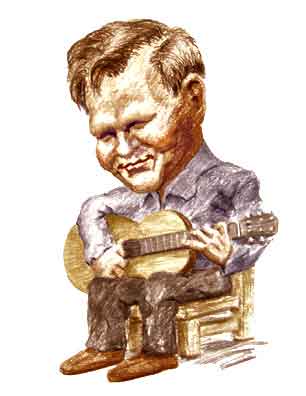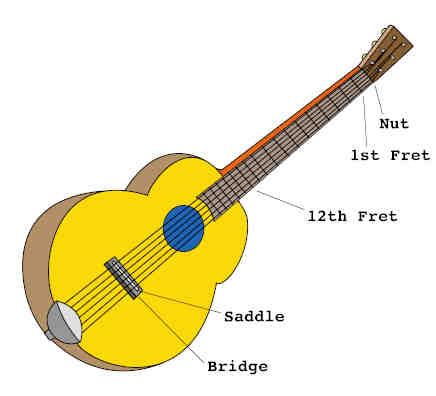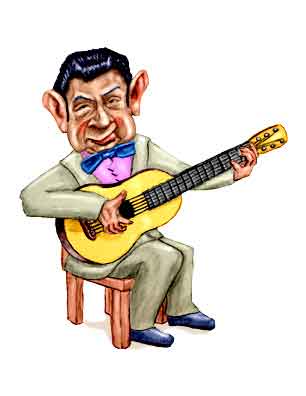Paco de Lucia

(Click on the image to zoom in.)
Flamenco as an art encompasses a combination of cante (singing), baile (dancing), and toque (music). The singers help establish the rhythm by clapping their hands, tapping a wooden surface, or striking the floor with a cane (the palo seco). The dancer also produces rhythmic clapping (sometimes aided by castanets) and foot stamps (called flats). There are male flamenco dancers but the usual image is of the tall statuesque bailaora whose vigorous steps and stylized gestures are enhanced by the motions of her long and swirling costume.
As far as the name, Flamencos are natives of Flanders. But the art itself came from Andalusia which the southernmost province on the Iberian peninsula. The connection between north Belgium and Southern Spain has been the subject of much, albeit inconclusive, discussion.
But it is definitely known that flamenco arose from the Romani people of Spain. Originally from India, the Romani - commonly referred to as Gypsies but more specifically in Spain they are known as the Gitano1 - immigrated into Spain beginning in the 9th Century. In Andalusia they met the Moorish Muslim and Sephardic Jewish inhabitants and the cultural borrowings between the groups ultimately produced unique songs, dance, and music. Flamenco singing and dancing was performed at family gatherings, parties, and weddings.
Footnote
As the word "Gypsy" is derived from "Egypt" and "Egyptian", so "Gitano" is derived from "Egipto" and "Egiptano" which is the Spanish for "Egypt" and "Egyptian". The idea was that "Gypsies" are from Egypt got around although as we said the Romani originated in India.
Because Spanish differentiates between male and female in it's grammatical endings, the feminine form is Gitana. The traditional language of the Gitanos is called Caló, which is a Romance language but quite distinct from Spanish or Portugese.
Because "Gypsy" and "to gyp" - that is, to cheat someone - are etymologically related (gyp < Gypsy as etymologist write it), the world "Gypsy" is sometimes considered a derogatory term. Use of "Romani" or "Roma" is preferred. "Gitano", though, still seems to be acceptable.
Then there is the guitar. Ironically, the guitar was not considered that important in the olden days and it wasn't until the mid-19th Century that the guitar became part of the act.
Why did it take (literally) centuries for the guitar to produce the sound that now virtually defines flamenco? Well, for one thing, guitars, then as now, were expensive and the early flamenco performers didn't always have a lot of cash on hand. Also if you were a traveling performer, a guitar was just one more piece of luggage to weigh you down. A capella singing required little more than the clothes on your back.
But in Spain - and throughout the world - the mid-19th Century saw the rise of the cities and with the cities' came cafes and restaurants. The owners of the new establishments found that they could pull in more customers by adding entertainment, and after a while the entertainment became the main attraction. Soon these what were known as cafés cantantes were specializing in flamenco singing, dancing, and music.
Soon the singers found themselves playing second fiddle to the dancers who began performing without los cantaores. But you always needed music even if it was la musica pero sin cantar.
It was also in the mid-19th century that a cabinet maker named Antonio de Torres Jurado began making guitars as a sideline. He modified the usual design, making his guitars larger and louder than the earlier instruments. A Torres soon became the Stradivarius of the Guitar and was the first instrument to clearly have the modern design. He also began differentiating construction of the guitar when it was intended for solo performances in concerts and recitals - the "classical" guitar - and when it was used for flamenco.
The flamenco guitar, then, is not quite the same as a classical guitar. Traditionally the most obvious difference was that the tuning keys on a flamenco instrument were friction pegs like on the violin while the classical guitar has geared tuners. It's hard to explain why flamenco players preferred the simpler designs as anyone who has tuned an instrument with friction pegs knows, the keys can be a bit touchy. They can slip, wear down, and are more difficult to fine tune to the right pitch. But you don't need to have the machined metal gears around, friction pegs are lighter and, perhaps more importantly, they are cheaper. Although today many flamenco guitars are built with geared keys, there are luthiers who still make the instruments with the friction pegs.
The flamenco guitar generally has as shallower body than the classical guitar, and you also read that the woods for the top are different although the various sources are not completely consistent on what uses what and where. You'll read the tops are made of cypress and in other places that they are of made of spruce. But it is agreed that flamenco guitars use thinner woods that produce a light instrument (some flamenco guitars weigh less than two pounds). The flamenco guitar produces a brighter sound while the classical guitar brings out more mellow tones.
Because rapid fire play is de rigueur on a flamenco guitar, the action - that is, the distance between the strings and the frets - is set low. The low action does make the instrument easier to play but also often produces a string contra fret buzz. Such extraneous noise is often deplored by the classical players who have no problem with "finger squeak" on the lower strings.2 But a bit of a buzz is considered acceptable - and sometimes even desirable and necessary - for the true flamenco sound.
Footnote
One way out of the squeaking noise - or at least to reduce it - is to go to flat wound strings. Bass strings on a guitar are made by wrapping thin metal wire around a core of nylon. Because the direction of the wires is perpendicular to the length of of the neck, sliding the fingers along the string produces a squeak. However, if the wrapping wire is not round but flat, the squeaking is much less. Treble strings - G, B, and E - are just nylon and so don't squeak.
Although flat wound strings reduce the squeak, most guitarists till use the round wounds. The usual opinion is round wire strings have a brighter tone and they are also cheaper.
The action is also kept low on a flamenco guitar by having the neck relief virtually nil. Neck relief is the amount of concave curvature in the neck that helps keep the strings above the frets. Admittedly the amount of bend is most unnoticeable and the extra height of the strings is no more than the thickness of a piece of thin cardboard. But if there is too much relief or the neck angle is set too high the guitar can be - as Doc Watson once put it - "as hard to fret as a barbed wire fence."
Finally the action can be lowered even more by using a capo. A capo is a bar that is placed across the neck behind a fret so it holds down all the strings at once. A capo pushes the strings a bit closer to the fingerboard than if they were just strung through the nut which is the grooved bar that separates the head from the neck. Use of a capo to lower the action is pretty common for flamenco guitarists although classical guitarists tend to indignantly eschew the device.
Normally a capo is used to allow the player to change the key of a tune without altering the left hand fingerings (Doc called his capo "the cheater"). So a flamenco player using a capo will also lower the pitch of the strings. Of course, modern capos are made so that the capo is padded where it touches the back of the neck to avoid scratching the finish. However, early capos looked like a great way to gouge the guitar.
You will read that Carlos Montoya was the first major flamenco guitarists to embark on a solo and concert career rather than just providing music for the dancer. Well, this is true in some sense. With the advent of the Second World War, Carlos immigrated to the United States and performed exclusively as a solo artist. He certainly became the most famous flamenco player to los norteamericanos who considered Carlos the épitomé of flamenco art.
On the other hand we have to mention - a surprise to his American fans - that Carlos is not generally held as one of the foremost players by scholars of the art. One major guitar reference work - which covers the entire history of the instrument from ancient to modern times - devotes a whole chapter to the flamenco guitar but only has a sentence or two about Carlos and then in a rather dismissive manner.
It may be tempting to ascribe the disdain that critics had of Carlos to sour grapes. After all he was the most successful guitarrista flamenco in North America and he played to sold out auditoria. But we must admit he did tend to produce a rough sound with heavy rasgueados which was quite unlike the crisp clean playing of some of his contemporaries such as Agustín Castellón Campos, know professional as Sabicas, or like the playing of his own uncle Ramón.
Ramón Montoya is held at the highest levels of flamenco playing and is sometimes called the single most important flamenco guitarist. He played solo concerts well before his nephew launched his career, but unfortunately, Ramón died in 1949. Fortunately, he did leave a number of recordings, which have been reissued as long playing albums.
Today Paco de Lucia - Francisco Sánchez Gómez - is considered one of the greatest flamenco tocaor and is often cited as #1 on the "Top Flamenco Players of All Time" lists. Known for his clean playing with an extremely fast picado3, Paco is one of the few flamenco guitarists to perform the Concierto de Aranjuez which was written for the classical guitar.3 His flamenco playing actually fits the music better than the strictly classical techniques, particularly his use of rasgueados in the first movement rather than simply strumming the strings.
Footnote
Picado is the rapid playing of individual notes using the index and middle fingers. The trick is to move the fingers from the knuckle - not the finger joints - and to minimize the distance the fingers move between notes. Since volume is important - you have to be heard above the dancers steps and the singer - the string is struck with considerable force and slightly downward so that it comes to rest on the strings above the one plucked. This technique is called picado apoyando or "supported picking".
The apoyando stroke is also common in classical guitar playing particularly when playing scales. Classical guitarists also pluck strings without bringing the finger to rest on the adjacent string - called the tirando ("pulling") stroke. The tirando stroke produces a weaker sound but allows the adjacent string to continue to vibrate. In flamenco the tirando stroke is not - as the Rabbi told Perchik - specifically forbidden but is not as common as when playing classical guitar.
Footnote
The Concierto de Aranjuez is often confused with the Fantasía para un gentilhombre which is another guitar concerto and both are by the Spanish composer, Joaquín Rodrigo. Generally the Concierto is considered harder to play and even the best professionals shudder at the difficult scale passages.
Once a famous classical guitarist was asked to play the Fantasía with a major symphony orchestra and he spent a month practicing. When he was picked up at the airport, he was handed the program and it listed the Concierto de Aranjuez.
"Who's playing the Concierto de Aranjuez", he asked.
Ha! Ha! everyone laughed. What a joke!
But soon it became evident that the organizer of the concert had confused the two concerti and the orchestra had been rehearsing the wrong piece. Fortunately through a herculean effort, the guitarist had the Concierto de Aranuez ready for the performance which received rave reviews.
The traditional flamenco artists often had little formal musical education and so the rules were relatively relaxed. For instance classical guitarists are taught to hold the guitar in a proper manner with the left foot elevated and the body resting against the left leg. On the other hand there are three basic ways for flamenco guitarists to hold the instrument. Certainly, you can hold it in the classical guitar manner if you wish (as Sabicas sometimes did). But then there's also the "old school" flamenco where the arms provide considerable support (as you see when watching Ramón) or the modern flamenco method which has a couple of variations (look at Paco de Lucia). If none of these suit you, well, you can hold the instrument pretty much how you like since el método para tocar la guitarra flamenca began when it was the music of the Traveling People.
References and Further Reading
Flamenco: The Art of Flamenco, Its History and Development Until Our Days, Barbara Thiel-Cramer, Remark, 1992
"The Complicated History of Flamenco in Spain", Sandie Holguín, Smithsonian, October 24, 2019
"Flamenco", Andy Aledort, ArtsFlamenco, The New York Center for Flamenco Performing Arts.
"Classical vs. Flamenco Guitars", Cordoba Guitars.
"The Flamenco Guitar", Guitar from Spain.
"11 Famous Flamenco Guitar Players (Of All Time)", Pranshu Nigam, Harmony Vine, July 21, 2023.
"Guitarristas flamencos: Los mejores guitarristas de la historia del flamenco", Cultura Sonora.
"Flamenco vs Classical Guitar: A Detailed Comparison", Music Vault, June 15, 2023.
"Carlos Montoya Brought Controversial Changes to Flamenco and Left a Mixed Legacy", Jason Webster, Classical Guitar, 2017.
"Paco de Lucia Discography", Discogs.
"Carlos Montoya Discography", Discogs.
"Ramón Montoya Discography", Discogs.



